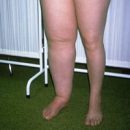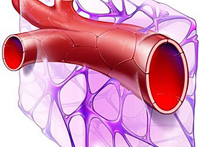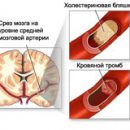Magnetic resonance angiography is one of the research methods that allows you to obtain a water image without the use of X-ray radiation. The main advantages of the method obtaining a clear image without catheterization and, accordingly, additional damage to the vessels.
Content
The concept of magnetic resonance angiography
Magnetic resonance angiography is a research method that allows you to obtain an image of organs and tissues of the body without the use of X-ray radiation. This method is that when the patient is irradiated with radio waves in a strong magnetic field, electromagnetic energy is released, which is fixed and processed using a computer. Magnetic resonance angiography is a magnetic resonance study of blood vessels. It is used to accurately diagnose and facilitate the choice of heart disease treatment, stroke and blood vessel diseases. Magnetic resonance angiography method allows you to obtain images of vessels without using any x-ray-contrast drugs, although special contrast agents are applied to obtain even clearer images. This is painless. In addition, there are no data about the impact of the magnetic field on the human fabric.
Main readings for research assignment
Most often, the method of magnetic resonance angiography is used to diagnose the following diseases:
- aneurysm - local extension of the aorta wall
- Aorti aneurysm bundle
- Congenital heart defects
- narrowing the artery of the kidney, that is, its stenosis
- Inflammation of the walls of the vessels - Vasculit
- Atherosclerosis - the process of deposit on the wall of vessels atheromatous plaques
- Sleepy arteries - narrowing of their lumen
Preparation for the study and principle of the apparatus.
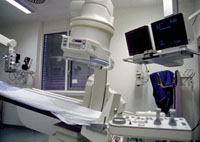 Before conducting magnetic resonance angiography, the patient receives a questionnaire in which it must indicate whether there is a metal objects in his body, such as artificial drivers of heart rhythm, artificial joints, ports for intravenous injections, metal plates, intrauterine spirals and T.D. This is done for the reason that metal objects may affect the receipt of a clear image. Before studying, the doctor will ask you to remove all metal items, decorations, clothes with metal buttons, wig, glasses and dentures. The red paint used in the tattoo, also contains iron salts, but their concentration practically does not affect the results of the method. Before studying, you should inform the doctor about the existing allergies to any drugs.
Before conducting magnetic resonance angiography, the patient receives a questionnaire in which it must indicate whether there is a metal objects in his body, such as artificial drivers of heart rhythm, artificial joints, ports for intravenous injections, metal plates, intrauterine spirals and T.D. This is done for the reason that metal objects may affect the receipt of a clear image. Before studying, the doctor will ask you to remove all metal items, decorations, clothes with metal buttons, wig, glasses and dentures. The red paint used in the tattoo, also contains iron salts, but their concentration practically does not affect the results of the method. Before studying, you should inform the doctor about the existing allergies to any drugs.
Usually you can eat before research (if otherwise indicated). If before that you took any drugs, you can also take them. Usually magnetic resonance angiography is carried out in a special chamber, in shape resembling a cylinder. Some patients may experience claustrophobic in a closed close space. Therefore, if necessary, they are given a sedative.
The principle of operation of a magnetic resonance study.
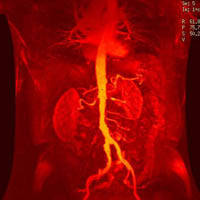 The patient is placed in a strong magnetic field and exposed to electromagnetic radiation (radio wave). The resulting electromagnetic energy is processed on the computer. This allows you to see the fabrics and human body layers from different positions and in different planes. The magnetic field knocks into the tissues of the particles of atoms - protons that accelerate electromagnetic radiation and produce signals. These signals are accepted by the device and then exposed to digital processing on the computer. The resulting image is very clear, allows you to view very small details.
The patient is placed in a strong magnetic field and exposed to electromagnetic radiation (radio wave). The resulting electromagnetic energy is processed on the computer. This allows you to see the fabrics and human body layers from different positions and in different planes. The magnetic field knocks into the tissues of the particles of atoms - protons that accelerate electromagnetic radiation and produce signals. These signals are accepted by the device and then exposed to digital processing on the computer. The resulting image is very clear, allows you to view very small details.
Contraindications for magnetic resonance angiography:
- body weight more than 130 kg
- The presence of an artificial driver of rhythm and other implanted in the body of patient devices, such as artificial prosthesis, dentures, artificial heart valves, metal plates, and t.D.
- pregnancy
- claustrophobia
What are the advantages and disadvantages of the method of magnetic resonance angiography?
Advantages of magnetic resonance angiography
Receiving a clear and detailed image of blood vessels without the need to use catheterization and, therefore, there is no risk of damage to the artery and related complications. The time spent on the research procedure and the rehabilitation period is shorter than the required angiography required. Less cost compared to contrast angiography. There is no need to irradiating the patient with X-rays and the use of radiocontrase drugs, which can be observed allergic to the patient
Disadvantages of magnetic resonance angiography
When using magnetic resonance angiography, there are no side effects. However, those who suffer from claustrophobia may be some problems. Sometimes to eliminate this problem requires the use of sedative (soothing) drugs.
In the presence of a metal implant in the field of research, if it was not revealed before that, or the patient did not mention it, he was damaged. In addition, the presence of a metallic design near the place of the study may prevent you from getting clear. Pregnancy - First Trimester. Pregnant patients instead of magnetic resonance angiography preferably use of ultrasound research methods.

